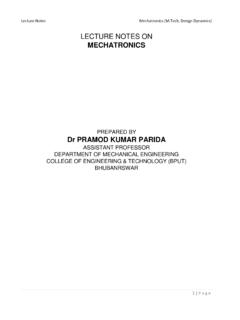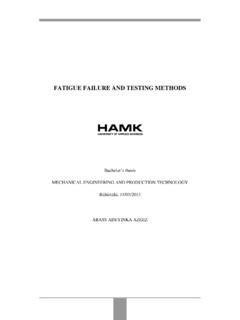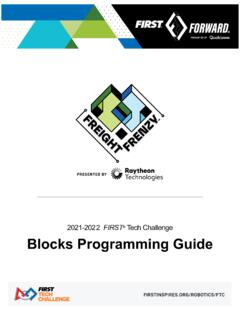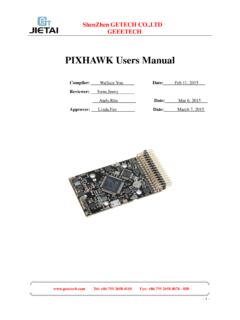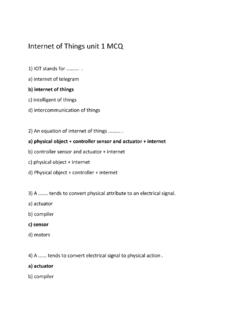Transcription of ELECTRICAL AND ELECTRONICS ENGINEERING
1 ELECTRICAL AND ELECTRONICS ENGINEERING ELECTRICAL and ELECTRONICS ENGINEERING LIST OF COURSES Course Code Course Name L:T:P Credit 1 18EE1001 Basic ELECTRICAL ENGINEERING 3:1:0 4 2 18EE1002 Basic ELECTRICAL ENGINEERING Laboratory 0:0:2 1 3 18EE1003 Basic ELECTRICAL and ELECTRONICS ENGINEERING 3:1:0 4 4 18EE1004 Basic ELECTRICAL and ELECTRONICS ENGINEERING Laboratory 0:0:2 1 5 18EE1005 ELECTRICAL Workshop Practices 1:0:4 3 6 18EE2001 ELECTRICAL Circuit Analysis 3:1:0 4 7 18EE2002 Network Theory 3:0:0 3 8 18EE2003 Analog electronic Circuits 3:0:0 3 9 18EE2004 Analog electronic Circuits Laboratory 0:0:3 10 18EE2005 Electromagnetic Fields 3:1:0 4 11 18EE2006 ELECTRICAL Machines I 3:0:0 3 12 18EE2007 ELECTRICAL Machines - I Laboratory 0:0:2 1 13 18EE2008 ELECTRICAL Machines II 3:0:0 3 14 18EE2009 ELECTRICAL Machines II Laboratory 0:0:2 1 15 18EE2010 Power ELECTRONICS 3:0:0 3 16 18EE2011 Power ELECTRONICS Laboratory 0:0:2 1 17 18EE2012 Power Systems I 3:0:0 3 18 18EE2013 Power Systems I Laboratory 0:0:2 1 19 18EE2014 Power Systems II 3:0:0 3 20 18EE2015 Power Systems II Laboratory 0:0.
2 2 1 21 18EE2016 Wind and Solar Energy Systems 3:0:0 3 22 18EE2017 Wind and Solar Energy Laboratory 0:0:2 1 23 18EE2018 Industrial Mechatronics 3:0:0 3 24 18EE2019 Electric Machines and Drives 3:0:0 3 25 18EE2020 Electric Machines and Drives Laboratory 0:0:2 1 26 18EE2021 ELECTRICAL Machines and Power Systems 3:0:0 3 27 18EE3001 Energy ENGINEERING 3:0:0 3 28 18EE3002 Photovoltaic Systems 3:0:0 3 29 18EE3003 Energy Management and Audit 3:0:0 3 30 18EE3004 Wind Energy 3:0:0 3 31 18EE3005 Solar Energy Laboratory 0:0:4 2 32 18EE3006 Electric Drives Laboratory for Renewable Energy 0:0:4 2 33 18EE3007 Wind Energy Laboratory 0:0:4 2 34 18EE3008 Power ENGINEERING Simulation Laboratory 0:0:4 2 35 18EE3009 Solar Thermal Energy Conversion 3:0:0 3 36 18EE3010 Materials for Solar Power 3:0:0 3 37 18EE3011 Solar Cell and Module Technology 3:0:0 3 38 18EE3012 Grid Converters for Solar and Wind Power Systems 3:0:0 3 39 18EE3013 Biomass Energy 3:0:0 3 40 18EE3014 Waste to Energy Conversion 3:0:0 3 41 18EE3015 Oceanic Energy 3:0:0 3 42 18EE3016 Data Mining for Renewable Energy Systems 3:0.
3 0 3 43 18EE3017 Power Conversion and Control of Wind Energy Systems 3:0:0 3 44 18EE3018 Power Quality Issues and Mitigation 3:0:0 3 45 18EE3019 Distributed Generation and Micro grid 3:0:0 3 ELECTRICAL and ELECTRONICS ENGINEERING 46 18EE3020 Cyber Physical Systems Approach To Smart Grid 3:0:0 3 47 18EE3021 Smart Power Grid Renewable Energy Systems 3:0:0 3 48 18EE3022 Electric and Hybrid Vehicles 3:0:0 3 49 18EE3023 Disaster Management 3:0:0 0 18EE1001 Basic ELECTRICAL ENGINEERING L T P C 3 1 0 4 Course Objectives: 1. To impart the basic knowledge about the DC, AC and Magnetic circuits.
4 2. To comprehend the working of various ELECTRICAL Machines. 3. To know about various power converters and ELECTRICAL installations. Course Outcomes: At the end of this course students will demonstrate the ability to 1. Describe the basic terminologies of DC, AC circuits. 2. Define the basic concepts of Magnetic circuits and transformers. 3. Predict and analyze the behavior of any circuits. 4. Identify the type of ELECTRICAL machine used for required application. 5. Classify various means of power conversion methodologies. 6. Plan ELECTRICAL wiring, earthing for house hold and commercial purposes.
5 Module 1: DC Circuits (10 hours) ELECTRICAL circuit elements (R, L and C), voltage and current sources, Kirchoff s laws, analysis of simple circuits with DE excitation. Superposition, Thevenin and Norton Theorems, Time-domain analysis of first-order RL and RC circuits. Module 2: AC Circuits (12 hours) Representation of sinusoidal waveforms, peak and RMS values, phasor representation, real power, reactive power, apparent power, power factor. Analysis of single-phase AC circuits consisting of R, L, C, RL, RC, RLC combinations (series and parallel), resonance. Three phase balanced circuits, voltage and current relations in star and delta connections.
6 Introduction to Three phase system. Module 3: Magnetic Circuits & Transformers (8 hours) Magnetic materials, B-H characteristics, Basics of ideal and practical transformer, equivalent circuit, losses in transformers, regulation and efficiency. Auto-transformer and three-phase transformer connections. Module 4: ELECTRICAL Machines (10 hours) Construction, working principle, types and applications of DC Generator, DC Motor, Three phase & Single-Phase Induction Motor, Synchronous Generator, Stepper Motor and servo Motor. Module 5: Introduction to Android Platform (11 hours) Introduction to Android platform UI widgets UI managers different devices &drawables Intents & fragments styles and themes data storages Asynctask Broadcast receiver notification and GCM applications Module 6: ELECTRICAL Installations (9 hours) Components of LT Switchgear: Switch Fuse Unit (SFU), MCB, ELCB, MCCB, Types of Wires and Cables, Earthing.
7 Types of Batteries, Important Characteristics for Batteries. Elementary calculations for energy consumption, power factor improvement and battery backup Text Books: 1. Kothari D. P, NagrathI. J., Basic ELECTRICAL ENGINEERING , Tata McGraw Hill, 2010. 2. Kulshreshtha D. C., Basic ELECTRICAL ENGINEERING , McGraw Hill, 2011 Reference Books 1. L. S. Bobrow, Fundamentals of ELECTRICAL ENGINEERING , Oxford University Press, 2011. 2. E. Hughes, ELECTRICAL and ELECTRONICS Technology , Pearson, 2010. 3. Vincent Del Toro, ELECTRICAL ENGINEERING Fundamentals , Prentice Hall India, 2nd Edition, 2013.
8 ELECTRICAL and ELECTRONICS ENGINEERING 4. Bhattacharya. S. K, Basic ELECTRICAL and ELECTRONICS ENGINEERING , Pearson Education, New Delhi, 2011. 5. 18EE1002 Basic ELECTRICAL ENGINEERING Laboratory L T P C 0 0 2 1 Co-requisite: 18EE1001 Basic ELECTRICAL ENGINEERING Course Objectives: 1. To learn the basic safety of ELECTRICAL ENGINEERING and measuring instruments. 2. To know the working of various AC, DC Circuits and ELECTRICAL Machines. 3. To be familiar with various power converters and ELECTRICAL installations. Course Outcomes At the end of this course students will demonstrate the ability to 1.
9 Get an exposure to common ELECTRICAL components and their ratings. 2. Make ELECTRICAL connections by wires of appropriate ratings. 3. Understand the usage of common ELECTRICAL measuring instruments. 4. Understand the basic characteristics of transformers and ELECTRICAL machines. 5. Get an exposure to the working of Switchgears. 6. Get an exposure to use of Android and projects with android. Description: The laboratory will demonstrate the student about the certain basic concepts in ELECTRICAL ENGINEERING . List of experiments: 1. Study of basic safety precautions; Introduction and use of measuring instruments voltmeter, ammeter, multi-meter, oscilloscope.
10 Real-life resistors, capacitors and inductors. 2. Measuring the steady-state and transient time-response of R-L, R-C, and R-L-C circuits to a step change in voltage (transient may be observed on a storage oscilloscope). 3. Sinusoidal steady state response of R-L, and R-C circuits impedance calculation and verification. 4. Stair case wiring, Fluorescent tube light wiring, Comparison of LED and CFL wiring. 5. Observation of phase differences between current and voltage, Resonance in R-L-C circuits. 6. Demonstration of cut-out sections of machines: DC machine, Induction machine, Synchronous machine and single-phase induction machine.



